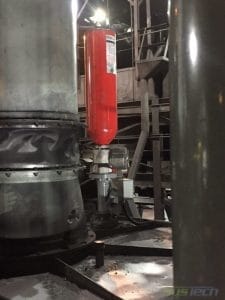Explosion protection systems that are designed and installed by experts can provide a safe and reliable system to safe guard employees against the catastrophic results of an industrial dust explosion. One of more challenging aspects for proper installation is locating explosion protection equipment on the ducting/piping system. Extinguishers or valves are typically installed on ducts/pipes to keep the explosion from propagating to other parts of the plant. However, stopping an explosion in it tracks requires great forces of its own accord and the ducting system needs to withstand those loads as well. We have reviewed many applications where this aspect can be overlooked.
Recently, we performed a walk-thru of an installed IEP Technologies explosion suppression system on a Mill and Classifier. The mill and classifier are a closed loop system where the client was handling graphite dust with a Kst of 83. The photo shows an IEP PistonFire extinguisher positioned on top of the collection vessel with a flex connector between the vessel and associated duct system. Flex connectors are used to isolate vibration from the process equipment and ducting. However, when the explosion protection system is called into action, the process vessel and attached ducting systems need to withstand the reaction loads. There is a mechanical load from the extinguishers discharging. There is also a pressure load from the suppressed explosion, which includes the pressure from the extinguisher itself.
Our experience strongly suggests that “off the shelf” flex material can’t handle the pressures associated with Pred. Pred is the “reduced pressure” from a successful suppression of the deflagration. NFPA 69, the governing code for explosion suppression and isolation systems, requires in Section 11.1.6 that the piping and ducts protected by an explosion isolation system be designed to withstand the estimated pressures as provided by the isolation system manufacturer. In this case, IEP’s Atex approved isolation software predicts that the ducting pressure will be 2X Pred at the point of isolation.
This piece of flex connector doesn’t pass the “eye test” and most likely won’t handle the pressure produced by an explosion nor will it handle the pressure of the bottle discharging. This could lead to flame ejection into the manufacturing area where personal could be working. If faced with this issue, check with your flex connector supplier to see if they have a documented pressure rating and then confirm that the pressure rating is above 2X Pred pressure level. Otherwise avoid it and construct the duct without a flex connector.
Solution to the question is clear…be aware that all mechanical contractors do not recognize and address all aspects associated with installing explosion protection systems. Mechanical skills aside, experience should be a factor in the selection process. Make explosion protection a top priority and don’t ignore the small details – call us at 800-456-9460 and we’ll make sure your facility and people are protected.
*Because there are multiple construction material options used in flex connector manufacture, the manufacturer of the flex connector must be contacted to confirm the device is capable of withstanding the pressures created during an EP System (Explosion Protection System) actuation.



